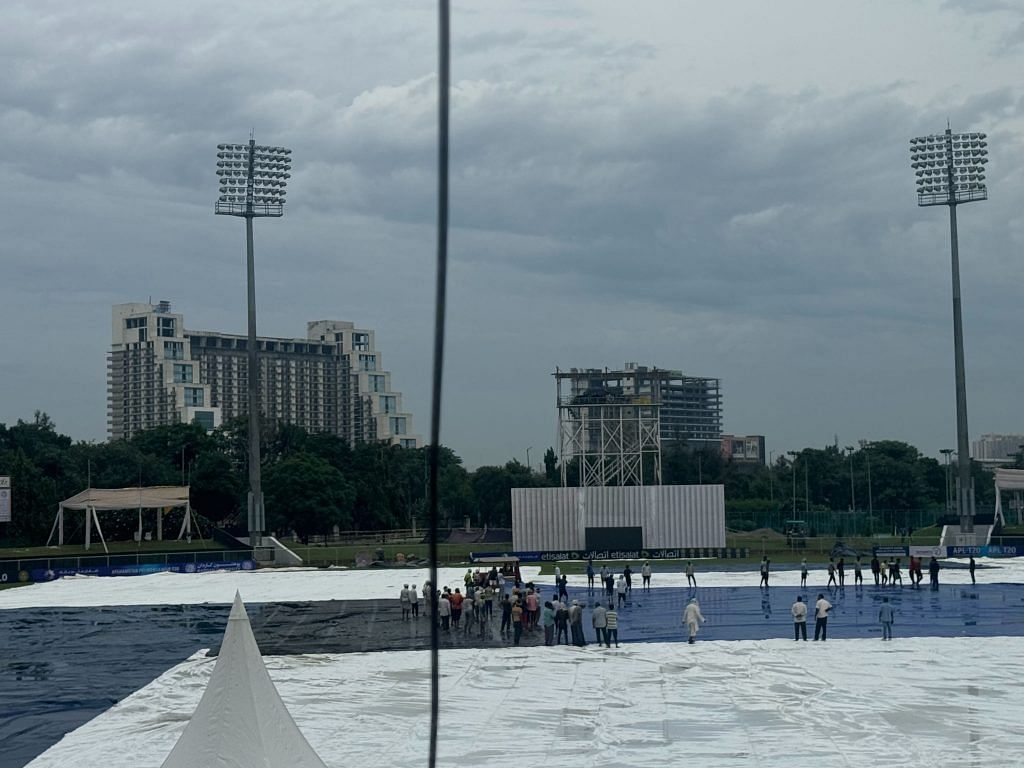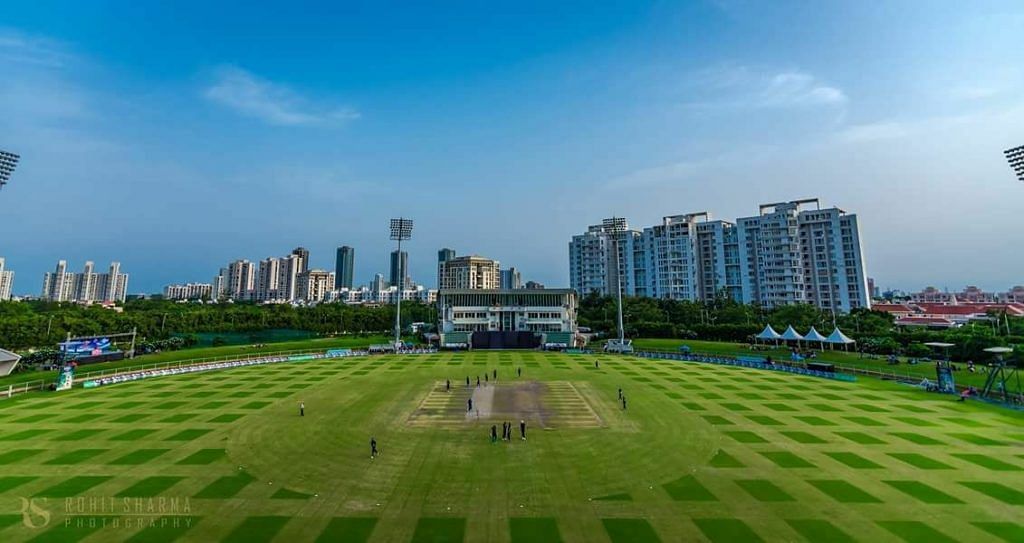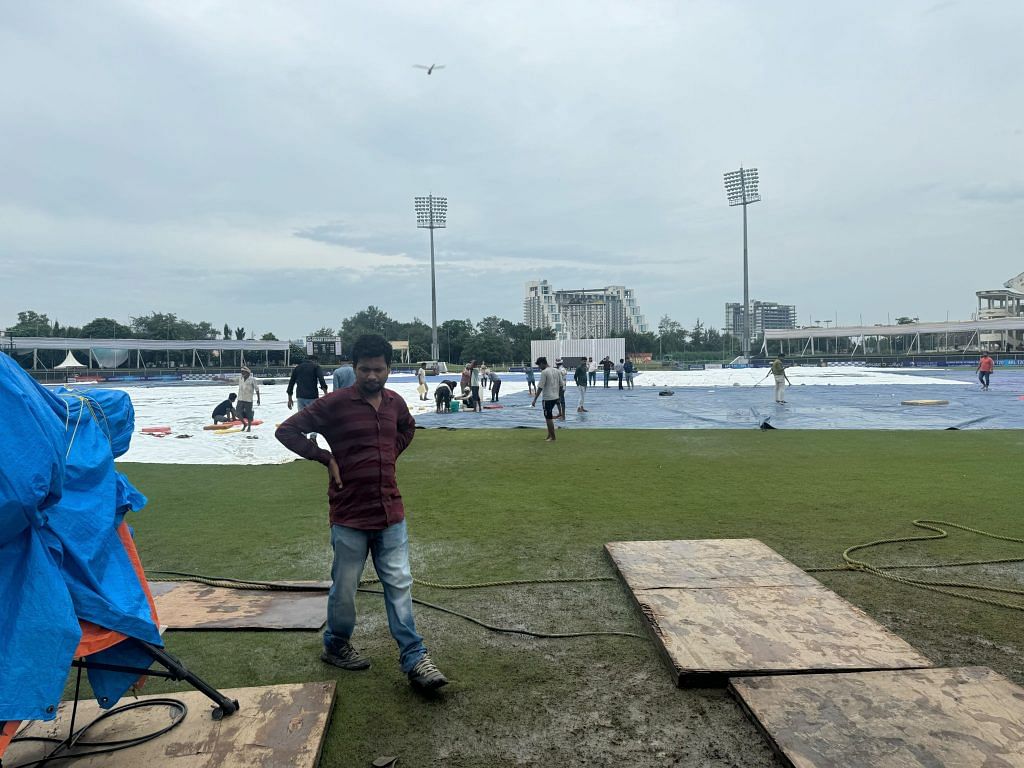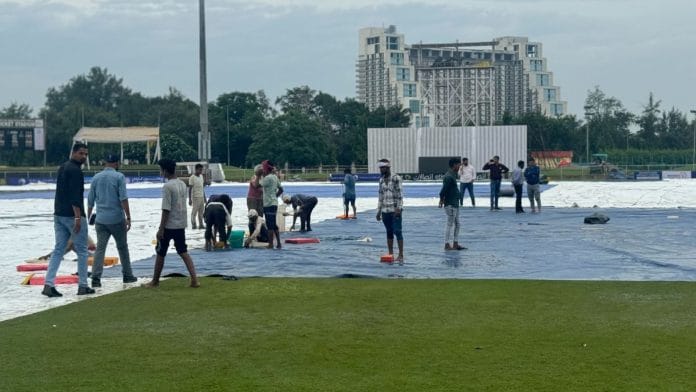Greater Noida: It was an emergency at Shaheed Vijay Singh Pathik Sports Complex in Greater Noida. A test match and India’s reputation as a cricketing powerhouse with world class infrastructure was on the line. Over three dozen labourers scurried across the drenched ground. Their ammunition? Foam pads and buckets. The responsibility to ensure the first ball was bowled in the one-off Test between Afghanistan and New Zealand lied on their shoulders. And more than anybody else, it was the Greater Noida Industrial Development Authority—responsible for the upkeep of the stadium—that appeared losing the script to poor preparedness.
On day three of the Test, desperate attempts were made, applying rudimentary labour-extensive practices of pressing the foam pads into water and wringing them in plastic buckets – soak, squeeze and repeat. But it all fell short of making the ground breath and be play ready.
The first ever international Test match at the Greater Noida Stadium has seen all the action on the ground, except players were not party to it, at least for the first three days. From deploying electric fans and blocks of dry grass to make the outfield playable, to an SoS call to Delhi’s Arun Jaitley Stadium for arranging effective rain covers, the managers of the game have shown how unprepared they were hosting a game during peak monsoon in India. The match has left not only players but also the fans frustrated who had come from other NCR cities such as Gurugram on the first day to watch the match. The drainage system at the grounds failed to handle the rainfall a day before the match, leading to the pouring out of water onto the field.
In a sign of things to come, Afghanistan’s Ibrahim Zadran suffered an ankle sprain during the practice match after slipping on a wet outfield ahead of the first day. Now, the team finds itself confined to their five-star hotel, Crowne Plaza, dealing with the consequences of a logistical choice of venue that has backfired but not before exposing a leaky sporting infrastructure.
We are praying to the rain gods to stop humiliating us now. Maan hi nahi rahe (The rain god is not listening) — a Greater Noida Authority official

The choice of the venue, which is often deemed inadequate even for Ranji Trophy matches is now under question. But the Afghanistan Cricket Board (ACB), the host of the match, maintains their preliminary inspection had found no cause for concern.
“An inspection with New Zealand representatives revealed no major issues, though the venue was somewhat small. We also inquired about an emergency Response Team with the Greater Noida administration and were assured of the same,” said Afghanistan Cricket Board manager Menhajuddin Naz.
The Noida stadium is the Afghanistan cricket team’s home turf and they have hosted Ireland and Zimbabwe in the past playing white-ball cricket. But that was four years ago. Afghanistan was presented with three venue options: Kanpur, Bengaluru and Greater Noida. But Naz said that Greater Noida stadium was a logistical choice as it was near the capital city.
An inspection with New Zealand representatives revealed no major issues, though the venue was somewhat small. We also inquired about an emergency Response Team with the Greater Noida administration and were assured of the same — Menhajuddin Naz Afghanistan Cricket Board manager
Arun Dhumul, former BCCI treasurer and IPL chairman told ThePrint that choosing a venue is a very important step and this serves as a “lesson for Afghanistan”.
“It is a lesson for Afghanistan. Now, they will take a better call next time. Afghanistan Cricket Board (ACB) was presented with options in Mohali, Bengaluru, Kanpur. But they chose Greater Noida because of its proximity to the national capital and a better fan base. It was not a BCCI venue which could have handled any calamity,” said Dhumul.
Dhumul said that BCCI is now getting in touch with ACB to better understand the situation. “We are here to help them,” he added.
But an ACB official, speaking on condition of anonymity, said they had made last-minute calls to BCCI to change the venue but the request was not accommodated.
Also read:
A test of infrastructure
A day before the match was about to begin, it rained in Greater Noida and adjoining areas and the conditions were overcast with high chances of rain. But it took one more day of play lost for the organisers to realise the stadium didn’t have effective rain covers.
That’s when they took the help of Delhi and District Cricket Association (DDCA) and big tarpaulin like rain cover used in international matches was borrowed from Arun Jaitley stadium. The cover reached only on the evening of day two. By then, the situation had worsened with the venue seeing more rains.

A mid-level Greater Noida Authority official was on duty, monitoring the labourers and occasionally gesturing to demonstrate how the work should be done. “Arre, ache se nichodo foam ko balti mein! (Wring the foam properly into the bucket).”
Meanwhile, another authority official stood in the middle of the field on a blue rain cover, with his pants rolled up, recording the labourers’ work on his phone to send to the head office.
We have come to an understanding that the soil is not suitable for quick drainage as it is clay-based – a GNIDA official
Everyone is tight-lipped and instructed not to speak about the fiasco of the Greater Noida administration. ThePrint contacted the Greater Noida DM Manish Kumar via phone and messages, and sent mail to GNIDA but didn’t receive any response.
“We are praying to the rain gods to stop humiliating us now. Maan hi nahi rahe (The rain god is not listening),” said the official on condition of anonymity.
The groundsmen, who mostly consisted of labourers and mid-level GNIDA staff, came up with ideas to make the area play ready and quickly found themselves part of the social media memes. On the first day of the match, groundsmen were seen using electric pedestal fans to dry the wet patches.
The grass on the patches, which were soggy and muddy were cut and replaced with blocks of dry grass from the outdoor nets area.
On the second and the third day, the ground staff was missing and labourers brought from Labour Chowk replaced them. They were paid Rs 500 for the day’s job. Rugs were laid out on the wet field to soak the water. The crude practices did not yield any results but the theatre of absurd was on full display at the Noida stadium.

The mismanagement spread throughout the stadium, away from the playing arena into the stands.
On day one, journalists who had come to cover the Test were made to sit on grass under a white tent. After they raised concerns, they were shifted to the VIP box. The Authority official present at the stadium said they were expecting a lot of visitors for the match and hence the reservation of the VIP box.
The stadium does not have spectator seats and the Authority officials justified their absence, saying the fans would sit on the grass, just like they do in New Zealand and Australia.
“But we don’t have the infrastructure of New Zealand and Australia,” mocked another official.
The Test saw several rounds of discussions between the ACB officials and the GNIDA.
“We have come to an understanding that the soil is not suitable for quick drainage as it is clay based,” said the GNIDA official mentioned above, monitoring the rescue work who didn’t wish to be named.
The Greater Noida stadium also carries a burden of ban by BCCI on its shoulders since 2017 due to match fixing allegations during corporate matches. The BCCI has not hosted a single match at the venue since then.
Also read:
Calling for covers
The Authority had six months to make the venue match ready. But no help was sought from the Uttar Pradesh Cricket Association, despite it being their own state’s association.
Ankit Chatterjee, CEO of the Uttar Pradesh Cricket Association (UPCA), told ThePrint they were not officially informed about the match and did not receive any requests for assistance until the GNIDA failed to manage the Test after the rain.
“There was no timely communication. Ideally, GNIDA should have informed us. But at the last moment, when they asked us for super soppers and scorers, we helped them out,” said Chatterjee.
Chatterjee said that the stadium complex in Greater Noida falls under the jurisdiction of GNIDA and the UP Cricket Association had no role to play in that.
In such cases, high-quality rain cover, pitch cover, highly knowledgeable ground staff and super soppers are required to keep the field dry – Ankit Chatterjee, CEO of the Uttar Pradesh Cricket Association
But now, the two super soppers borrowed by the UPCA are lying unsed. The GNIDA official mentioned above said that the field was so wet and soggy that the super soppers were creating further muddy patches. Hence the manual work of soak and squeeze.
Chatterjee said the timely presence of thick rain covers that are present at international venues would have saved the day for the GNIDA.
“In such cases, high quality rain cover, pitch cover, highly knowledgeable ground staff and super soppers are required to keep the field dry,” said Chatterjee.
The Greater Noida stadium did not have enough covers to protect the entire playing area.
However, Ram Krishna, manager of the Shaheed Vijay Singh Pathik Sports Complex said that they didn’t have enough time to cover the entire field.
“Afghanistan team arrived on 28 September and they played practice matches with some Ranji players…it was raining slightly back then too. The New Zealand team arrived on 6 September and did their practice sessions. But they didn’t flag any concerns,” said Krishna.
Speaking about the drainage system that overflowed with water, Krishna said that the rain was so heavy that the drain could not hold it any longer.
“There is a limit to everything, the rain is falling continuously and the drain could not handle it. The entire city was flooded. Even the matches of Delhi Premier League at Arun Jaitley stadium got cancelled,” he said on his way to the ground again at 8 pm on day three of the Test.
Krishna said they tried everything but couldn’t get a two-hour window from rain to dry the outfield.
“Even PM Modi couldn’t come in a chopper because of the weather situation. He had to come via road,” he said, referring to the prime minister’s presence in Greater Noida on the same day for the inauguration of SEMICON India 2024.
Match referee Javagal Srinath is expected to go by the rulebook and wait till the fifth day’s first session before the game is abandoned. The match is likely to join the list of rare games that were abandoned without a ball being bowled. Calls and messages to Srinath went unanswered.
A rare opportunity for Afghanistan, it was their 10th match after receiving the Test status seven years ago in 2017.
At the Crowne Plaza Hotel in Greater Noida, where the teams are staying, an uneasy silence hangs in the air. Players are milling around in the lounge, discussing the disappointing turn of events.
An ACB member sitting in the lobby asked, “Hasn’t India been to the Moon? Yet they can’t manage rainfall at a cricket stadium.”
“We have another match with South Africa (in UAE). We are looking forward to that.”
(Edited by Anurag Chaubey)






